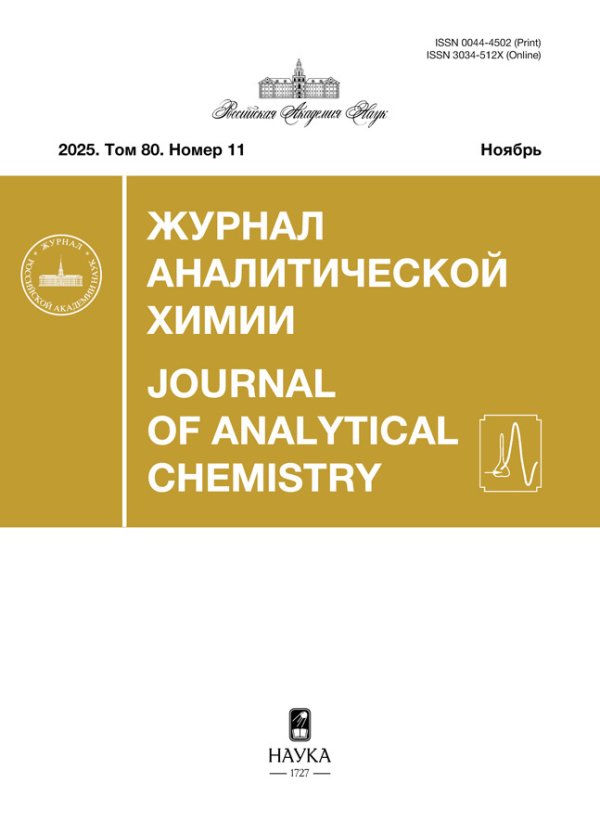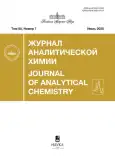Voltammetric sensor based on tin dioxide nanoparticles for the determination of taxifolin
- Authors: Ziyatdinova G.K.1, Tarabukina A.D.1
-
Affiliations:
- Kazan Federal University
- Issue: Vol 80, No 7 (2025)
- Pages: 722-733
- Section: ORIGINAL ARTICLES
- Submitted: 19.07.2025
- Accepted: 19.07.2025
- URL: https://vestnik.nvsu.ru/0044-4502/article/view/687908
- DOI: https://doi.org/10.31857/S0044450225070071
- EDN: https://elibrary.ru/bhvuoz
- ID: 687908
Cite item
Abstract
A voltammetric sensor based on a glassy carbon electrode (GCE) modified with tin dioxide nanoparticles dispersed in N-hexadecylpyridinium bromide (NPs SnO2) was developed for the determination of taxifolin. Modification of the electrode surface provides an increase in the reversibility of the electrode reaction, as well as a significant increase in the redox currents compared to GCE (2.3 and 3.3 times for the anodic and cathodic peaks, respectively). The morphology of the electrode surface according to scanning electron microscopy data is represented by uniformly distributed on the electrode surface SnO2 NPs of spherical shape with a diameter of 20-40 nm, which leads to a 3.9-fold increase in the effective area of the electrode and a 143-fold increase in the heterogeneous electron transfer rate constant. The electrooxidation of taxifolin was found to proceed with the participation of protons. Mixed control with diffusion and adsorption contributions was confirmed for the electrode reaction. In differential pulse mode against Britton-Robinson buffer with pH 6.0, the range of determined taxifolin contents is 0.075-25 μM with a detection limit of 70.7 nM. The obtained characteristics are comparable to other electrochemical approaches, but the proposed approach is simpler and more rapid, and does not require complex modification of the electrode. The developed sensor was successfully applied in the analysis of dihydroquercetin (taxifolin) based bioadditives. The results obtained were compared with the data of coulometric titration by electrogenerated bromine.
Full Text
About the authors
G. K. Ziyatdinova
Kazan Federal University
Author for correspondence.
Email: Ziyatdinovag@mail.ru
A.M. Butlerov Chemical Institute
Russian Federation, KazanA. D. Tarabukina
Kazan Federal University
Email: Ziyatdinovag@mail.ru
A.M. Butlerov Chemical Institute
Russian Federation, KazanReferences
- Зиятдинова Г.К., Будников Г.К. Природные фенольные антиоксиданты в биоаналитической химии: состояние проблемы и перспективы развития // Успехи химии. 2015. Т. 84. № 2. C. 194. (Ziyatdinova G.K., Budnikov H.C. Natural phenolic antioxidants in bioanalytical chemistry: State of the art and prospects of development // Russ. Chem. Rev. 2015. V. 84. № 2. P. 194. https://doi.org/10.1070/RCR4436)
- Das A., Baidya R., Chakraborty T., Samanta A.K., Roy S. Pharmacological basis and new insights of taxifolin: A comprehensive review // Biomed. Pharmacother. 2021. V. 142. Article 112004. https://doi.org/10.1016/j.biopha.2021.112004
- Jain S., Vaidya A. Comprehensive review on pharmacological effects and mechanism of actions of taxifolin: A bioactive flavonoid // Pharmacol. Res. Modern Chin. Med. 2023. V. 7. Article 100240. https://doi.org/10.1016/j.prmcm.2023.100240
- Liu Y., Shi X., Tian Y., Zhai S., Liu Y., Xiong Z., Chu S. An insight into novel therapeutic potentials of taxifolin // Front. Pharmacol. 2023. V. 14. Article 1173855. https://doi.org/10.3389/fphar.2023.1173855
- Jomová K., Hudecova L., Lauro P., Simunkova M., Alwasel S.H., Alhazza I.M., Valko M. A Switch between antioxidant and prooxidant properties of the phenolic compounds myricetin, morin, 3′,4′-dihydroxyflavone, taxifolin and 4-hydroxy-coumarin in the presence of copper(II) ions: A spectroscopic, absorption titration and DNA damage study // Molecules. 2019. V. 24. № 23. Article 4335. https://doi.org/10.3390/molecules24234335
- Pierini G.D., Maccio S.A., Robledo S.N., Ferrari A.G.-M., Banks C.E., Fernández H., Zon M.A. Screen-printed electrochemical-based sensor for taxifolin determination in edible peanut oils // Microchem. J. 2020. V. 159. Article 105442. https://doi.org/10.1016/j.microc.2020.105442
- Ziyatdinova G., Aytuganova I., Nizamova A., Morozov M., Budnikov H. Cyclic voltammetry of natural flavonoids on MWNT-modified electrode and their determination in pharmaceuticals // Collect. Czech. Chem. Commun. 2011. V. 76. № 12. P. 1619. https://doi.org/10.1135/cccc2011115
- Wu Y., Lv M., Li B., Ge J., Gao L. A rapid, green and controllable strategy to fabricate electrodeposition of reduced graphene oxide film as sensing materials for determination of taxifolin // NANO: Brief Rep. Rev. 2015. V. 10. № 3. Article 1550044. https://doi.org/10.1142/S1793292015500447
- Wang F., Wu Y., Lu K., Ye B. A sensitive voltammetric sensor for taxifolin based on graphene nanosheets with certain orientation modified glassy carbon electrode // Sens. Actuators B. 2015. V. 208. P. 188. https://doi.org/10.1016/j.snb.2014.11.008
- Wang Q., Wang L., Li G., Ye B. A simple and sensitive method for determination of taxifolin on palladium nanoparticles supported poly (diallyldimethylammoniumchloride) functionalized graphene modified electrode // Talanta. 2017. V. 164. P. 323. https://doi.org/10.1016/j.talanta.2016.11.045
- Xu Y., Dong C., Li D., Liu P., Cao Q., Sun Y., Wei Y., Lu Y., Lu J., Zhang X. The sensing performance toward taxifolin and lithium storage property based on nickel-metal organic frameworks and carbon nanotubes composite // Inorg. Chem. Commun. 2021. V. 126. Article 108446. https://doi.org/10.1016/j.inoche.2021.108446
- Zhang X., Cao Q., Guo Z., Znahg M., Zhou M., Zhai Z., Xu Y. Self-assembly of MoS2 nanosheet on functionalized pomelo peel derived carbon and its electrochemical sensor behavior toward taxifolin // Inorg. Chem. Commun. 2021. V. 129. Article 108631. https://doi.org/10.1016/j.inoche.2021.108631
- Zhang X., Li D., Dong C., Shi J., Sun Y., Ye B., Xu Y. Molybdenum sulfide-based electrochemical platform for high sensitive detection of taxifolin in Chinese medicine // Anal. Chim. Acta. 2020. V. 1099. P. 85. https://doi.org/10.1016/j.aca.2019.11.057
- Huang D., Yang L., Li X.l., Zou L., Ye B. A new electrochemical sensor for taxifolin based on RGO-Co3S4@MoS2 modified electrode // J. Electroanal. Chem. 2019. V. 851. Article 113473. https://doi.org/10.1016/j.jelechem.2019.113473
- Ziyatdinova G., Gimadutdinova L., Antonova T., Grigoreva I., Yakupova E. The analytical capabilities of electrochemical sensors based on transition metal oxide nanomaterials // Eng. Proc. 2023. V. 48. № 1. Article 13. https://doi.org/10.3390/CSAC2023-14916
- Sharma A., Ahmed A., Singh A., Oruganti S.K., Khosla A., Arya S. Recent advances in tin oxide nanomaterials as electrochemical/chemiresistive sensors // J. Electrochem. Soc. 2021. V. 168. № 2. Article 027505. https://doi.org/10.1149/1945-7111/abdee8
- Matussin S., Harunsani M.H., Tan A.L., Khan M.M. Plant-extract-mediated SnO2 nanoparticles: synthesis and applications // ACS Sustainable Chem. Eng. 2020. V. 8. № 8. P. 3040. https://doi.org/10.1021/acssuschemeng.9b06398
- Зиятдинова Г.К., Антонова Т.С., Мубаракова Л.Р., Будников Г.К. Амперометрический сенсор на основе наночастиц диоксида олова и цетилпиридиния бромида для определения ванилина // Журн. аналит. химии. 2018. Т. 73. № 8. C. 632. https://doi.org/10.1134/S0044450218080121 (Ziyatdinova G.K., Antonova T.S., Mubarakova L.R., Budnikov H.C. An amperometric sensor based on tin dioxide and cetylpyridinium bromide nanoparticles for the determination of vanillin // J. Anal. Chem. 2018. V. 73. № 8. P. 801. https://doi.org/10.1134/S1061934818080129)
- Ziyatdinova G., Yakupova E., Davletshin R. Voltammetric determination of hesperidin on the electrode modified with SnO2 nanoparticles and surfactants // Electroanalysis. 2021. V. 33. № 12. P. 2417. https://doi.org/10.1002/elan.202100405
- Ziyatdinova G., Budnikov H. Analytical capabilities of coulometric sensor systems in the antioxidants analysis // Chemosensors. 2021. V. 9. № 5. Article 91. https://doi.org/10.3390/chemosensors9050091
- Bhattacharjee A., Ahmaruzzaman M., Sinha T. Surfactant effects on the synthesis of durable tin-oxide nanoparticles and its exploitation as a recyclable catalyst for the elimination of toxic dye: A green and efficient approach for wastewater treatment // RSC Adv. 2014. V. 4. № 93. P. 51418. https://doi.org/10.1039/C4RA08461F
- Boran F., Çetinkaya S., Şahin M. Effect of surfactant types on the size of tin oxide nanoparticles // Acta. Phys. Pol. A. 2017. V. 132. № 3. P. 546. http://doi.org/10.12693/APhysPolA.132.546
- Parry R.A., Dubey K., Modi A., Gaur N.K. Effect of surfactants on the structural, microstructural, optical, and photoluminescence characteristics of nanostructured SnO2 compounds // Results in Optics. 2024. V. 16. Article 100677. https://doi.org/10.1016/j.rio.2024.100677
- Bard A.J., Faulkner L.R. Electrochemical Methods: Fundamentals and Applications, 2nd Ed. New York: John Wiley & Sons, 2001. 864 p.
- Ziyatdinova G., Antonova T., Vorobev V., Osin Y., Budnikov H. Selective voltammetric determination of α-lipoic acid on the electrode modified with SnO2 nanoparticles and cetyltriphenylphosphonium bromide // Monatsh. Chem. 2019. V. 150. № 3. P. 401. https://doi.org/10.1007/s00706-018-2341-5
- Lasia A. Electrochemical Impedance Spectroscopy and Its Applications. New York: Springer, 2014. 36 p.
- Randviir E.P. A cross examination of electron transfer rate constants for carbon screen-printed electrodes using electrochemical impedance spectroscopy and cyclic voltammetry // Electrochim. Acta. 2018. V. 286. P. 179. https://doi.org/10.1016/j.electacta.2018.08.021
- Slabbert N.P. Ionisation of some flavanols and dihydroflavonols // Tetrahedron. 1977. V. 33. № 7. P. 821. https://doi.org/10.1016/0040-4020(77)80200-7
- Moura F.C.S., dos Santos Machado C.L., F.R. Paula, Couto A.G., Ricci M., Cechinel-Filho V., Bonomini T.J., Sandjo L.P., Bresolin T.M.B. Taxifolin stability: In silico prediction and in vitro degradation with HPLC-UV/UPLC–ESI-MS monitoring // J. Pharm. Anal. 2021. V. 11. № 2. P. 232. https://doi.org/10.1016/j.jpha.2020.06.008
- Chernikov D.A., Shishlyannikova T.A., Kashevskii A.V., Bazhenov B.N., Kuzmin A.V., Gorshkov A.G., Safronov A.Y. Some peculiarities of taxifolin electrooxidation in the aqueous media: The dimers formation as a key to the mechanism understanding // Electrochim. Acta. 2018. V. 271. P. 560.
- Зиятдинова Г.К., Низамова А.М., Будников Г.К. Гальваностатическая кулонометрия в анализе природных полифенолов и ее применение в фармации // Журн. аналит. химии. 2010. Т. 65. № 11. С. 1202. (Ziyatdinova G.K., Nizamova A.M., Budnikov G.K. Galvanostatic coulometry in the analysis of natural polyphenols and its use in pharmacy // J. Anal. Chem. 2010. V. 65. № 11. P. 1176. https://doi.org/10.1134/S1061934810110146)
Supplementary files

















